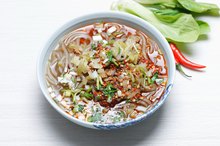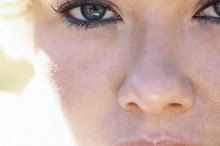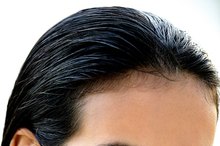Why Does My Face Go Red After Eating & When Its Hot?
Facial redness after you eat or when it’s hot is called facial flushing. Skin flushing causes your skin to turn bright red in various parts of your body, and the face is a common place to develop flushing. The color change is the result of increased blood flow to that part of your body, causing your blood vessels to dilate. Facial flushing can occur in various circumstances. For example, eating foods that are spicy or hot in temperature can cause facial flushing. Another cause of facial flushing is extreme temperature changes. Call your doctor to determine the cause of your symptoms.
General Flushing
General flushing that doesn’t cause any other symptoms is most likely the result of increased blood flow. MedlinePlus states that most general flushing from heat or eating will cause your face, upper chest and neck to turn red for a short time 1. Overexerting yourself also can cause your face to become flush. Avoid eating hot foods or drinking hot beverages and avoid environments with an increased heat index. During summer or winter, you might notice more flushing because of extreme temperature changes going between outdoors and indoors. Identify and avoid the various foods, beverages or environmental factors that trigger your symptoms.
- General flushing that doesn’t cause any other symptoms is most likely the result of increased blood flow.
- MedlinePlus states that most general flushing from heat or eating will cause your face, upper chest and neck to turn red for a short time 1.
Food Allergy
Redness on the Face After Eating
Learn More
Food allergies are a consideration when it comes to developing a red face after eating. Common foods that can cause:
- an allergic reaction include soy
- fish
- tree nuts
- peanuts
- wheat
- eggs
- milk
Eating these foods can trigger a chemical reaction throughout your body, leading to increased blood blow and inflammation in soft tissue. If you notice bumps or swelling in your face along with redness, call 911. These can be a sign of a serious allergic reaction called anaphylaxis.
- Food allergies are a consideration when it comes to developing a red face after eating.
- Common foods that can cause: * an allergic reaction include soy
* fish
* tree nuts
* peanuts
* wheat
* eggs
* milk Eating these foods can trigger a chemical reaction throughout your body, leading to increased blood blow and inflammation in soft tissue.
Alcohol
Some people experience facial flushing after drinking alcohol. If you notice that alcohol causes your face to turn red consistently, talk with your doctor. You might have a condition called alcohol intolerance, which can lead to further complications 3. The only treatment for alcohol intolerance is the avoidance of alcoholic beverages 3.
High Fever Consideration
Why Does My Nose Get Red When It's Cold?
Learn More
If you notice that you have a body temperature over 103 degrees, you need to call your doctor right away, according to MayoClinic.com 4. Facial flushing is a common sign of a high fever, which can be the result of a more serious condition. Call your doctor immediately if you’ve had a fever for more than three days, throat swelling, a rash, severe headaches, sensitivity to light, a stiff neck or mental confusion. If a fever gets too high, it can cause permanent damage to your body and even cause death.
- If you notice that you have a body temperature over 103 degrees, you need to call your doctor right away, according to MayoClinic.com 4.
- If a fever gets too high, it can cause permanent damage to your body and even cause death.
Related Articles
References
- MedlinePlus: Skin Blushing/Flushing
- MayoClinic.com: Alcohol Intolerance
- MayoClinic.com: Fever
- Lugo T, Tetrokalashvili M. Hot Flashes. [Updated 2019 Apr 5]. In: StatPearls. Treasure Island (FL): StatPearls Publishing; 2019 Jan-.
- Bansal R, Aggarwal N. Menopausal Hot Flashes: A Concise Review. J Midlife Health. 2019;10(1):6-13. doi:10.4103/jmh.JMH_7_19
- Rance NE. Menopause and the human hypothalamus: evidence for the role of kisspeptin/neurokinin B neurons in the regulation of estrogen negative feedback. Peptides. 2009;30(1):111-22. doi:10.1016/j.peptides.2008.05.016
- Freedman RR. Menopausal hot flashes: mechanisms, endocrinology, treatment. J Steroid Biochem Mol Biol. 2014;142:115-20. doi:10.1016/j.jsbmb.2013.08.010
- Carroll DG, Lisenby KM, Carter TL. Critical appraisal of paroxetine for the treatment of vasomotor symptoms. Int J Womens Health. 2015;7:615-24. doi:10.2147/IJWH.S50804
- Ghazanfarpour M, Sadeghi R, Abdolahian S, Latifnejad roudsari R. The efficacy of Iranian herbal medicines in alleviating hot flashes: A systematic review. Int J Reprod Biomed (Yazd). 2016;14(3):155-66.
- Schilling C, Gallicchio L, Miller SR, Langenberg P, Zacur H, Flaws JA. Current alcohol use, hormone levels, and hot flashes in midlife women. Fertil Steril. 2007;87(6):1483-6. doi:10.1016/j.fertnstert.2006.11.033
- Freedman, R. "Menopausal hot flashes: mechanisms, endocrinology, treatment.: J Steroid Biochem Mol Biol. 2014 Jul;142:115-20.
- The North American Menopause Society. The Menopause Practice: A Clinician’s Guide (5th Edition). 2014;ISBN 978-0-692-26135-4.
Writer Bio
Diane Marks started her writing career in 2010 and has been in health care administration for more than 30 years. She holds a registered nurse license from Citizens General Hospital School of Nursing, a Bachelor of Arts in health care education from California University of Pennsylvania and a Master of Science in health administration from the University of Pittsburgh.









